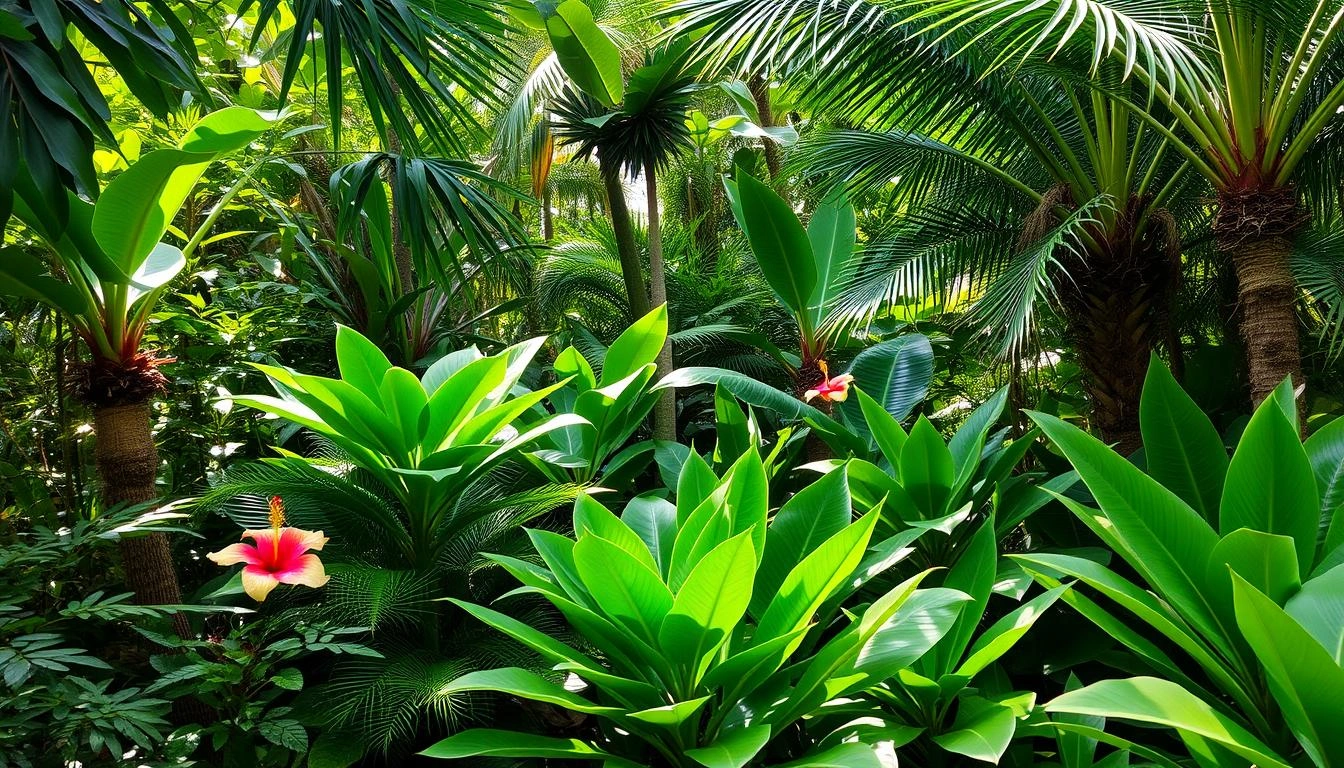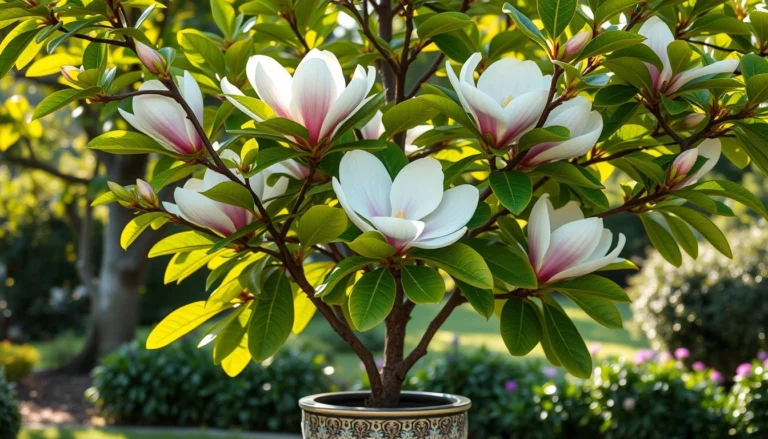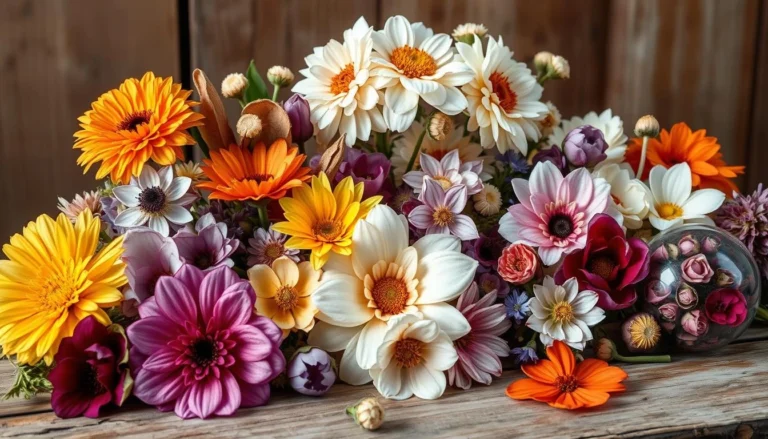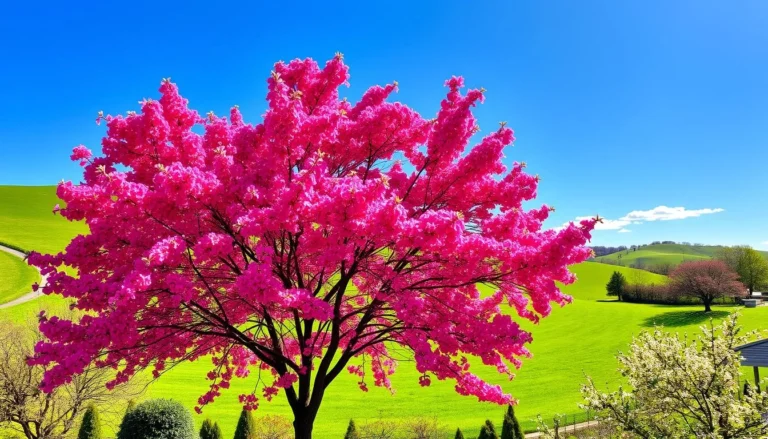“Tropical Plants: Secret Tips & Tricks for Ultimate Growth!”
Are you drawn to the lush, vibrant foliage of tropical plants? Do you dream of turning your space into a green oasis? Learning the secrets to caring for these plants is crucial for their growth. What if you could discover the hidden techniques used by professional gardeners to make their tropical plants flourish?
Tropical1 plants bring exotic beauty and charm to any setting. But, they have special needs that can be tricky for beginners. You’ll need to master humidity, temperature, soil, and watering to care for them well.
Key Takeaways
- Tropical plants prefer warm temperatures, typically between 65-85°F for optimal growth1
- Consistent moisture in the soil is crucial, requiring watering when the top inch feels dry1
- High-humidity environments are essential for thriving tropical plants, which can be achieved through humidifiers, pebble trays, and misting1
- Bright, indirect light that mimics the dappled sunlight of their native forests is the ideal lighting condition1
- Proper acclimation and gradual introduction is key when adding new tropical plants to your home1
Understanding Tropical Plant Requirements
Light Requirements for Tropical Indoor Plants
It’s key to give tropical indoor plants the right light to grow well. Most do best in indirect light that’s like the dappled sunlight they’re used to2. You can place them by a sunny window and use sheer curtains to soften the light. Direct sunlight can harm them, so finding the right balance is important3.
Popular plants like the peace lily, snake plant, and pothos can handle different lights3. But, they really shine in bright indirect light or filtered sunlight3. By placing them right and controlling the light, you can help them thrive indoors.
| Tropical Plant | Country of Origin | Mature Height | Pricing (5g / 15g) |
|---|---|---|---|
| African Tulip Tree | Arid areas of Africa | 20-75 feet | $95 / $195+ |
| Agave Octopus Agave (Agave vilmoriniana) | – | 4 feet | $95 / $195 |
| Agave Agave attenuata | – | 6 feet | $85 / $225 |
| Air Plants (Tillandsia Species) | Mexico down through Central America | – | $75 / $100-$150 |
“Proper lighting, watering, and fertilizing are crucial for the health and growth of tropical plants.”3
Mastering Humidity for Tropical Plants
Keeping the right humidity is key for your tropical plants. These plants love humid air, like the rainforests4. But, it can be hard to keep the humidity right at home, especially in dry winter months.
Tropical plants like humidity between 60% and 80%. Succulents and cacti prefer it drier, around 30% to 40%5. Ferns do well in slightly drier air, making them great for moist places like bathrooms or kitchens.
To help your plants, use a humidifier to control moisture4. You can also use pebble trays or group plants to make a humid spot4. Mist the leaves sometimes, but don’t overdo it to avoid too much water4.
Check the humidity with a hygrometer and adjust as needed5. By knowing what your plants need and using the right methods, you can make a lush indoor space6.
| Plant Type | Ideal Humidity Range |
|---|---|
| Tropical Plants | 60% – 80% |
| Succulents and Cacti | 30% – 40% |
| Ferns | 40% – 60% |
By understanding the unique humidity needs of your tropical plants and using the right methods, you can create a thriving indoor oasis that celebrates the lush, verdant beauty of these captivating species6.
“Proper humidity levels are essential for tropical plants to thrive and reach their full potential.”
Remember, the right humidity is just part of caring for your tropical plants. We’ll look at temperature, air circulation, and more to help your indoor jungle grow. Your tropical oasis awaits!
Temperature and Air Circulation Needs
Keeping the right temperature and air flow is key for your tropical plants’ health and growth. Most tropical plants like temperatures between 65-75°F (18-24°C)7. Succulents and cacti prefer warmer spots, around 70-85°F (21-29°C)7. Flowering plants do best in a range of 60-75°F (16-24°C)7.
It’s important to keep your plants away from cold temperatures below 50°F (10°C)7. Using thermometers and hygrometers helps ensure your plants get the best growing conditions7. Tropical plants usually thrive in warmer zones, not zones eight or colder8.
Changes in temperature can stress your plants. So, it’s best to slowly adjust them to any temperature changes7.
Good air circulation is also crucial for your plants. A gentle breeze, like from a fan, helps mimic their natural habitats9. This air movement prevents dust buildup on leaves, which can block gas exchange and photosynthesis9. It also keeps humidity levels right and prevents fungal problems9.
Place your tropical plants away from cold drafts and heat sources7. Instead, put them near fences or large trees for a warmer spot8. By giving your plants the right temperature and air flow, they’ll thrive and grow well.
Soil and Watering Techniques
Choosing the Right Potting Mix
Caring for tropical plants means focusing on soil and watering. They do best in peat-based potting mixes that keep the moisture right without getting too wet10. It’s key to avoid overwatering to prevent root rot11.
The best potting mix for these plants should drain well but still hold moisture. Look for mixes with peat moss, perlite, and vermiculite. These ingredients help your plants stay healthy and green10. Stay away from heavy soils that can block your plants’ growth12.
| Soil Component | Purpose |
|---|---|
| Peat Moss | Retains moisture and improves drainage |
| Perlite | Enhances aeration and prevents soil compaction |
| Vermiculite | Helps the soil hold water and nutrients |
Choosing the right well-draining soil and a consistent watering schedule is key. This way, your tropical plants will get the best chance to grow and thrive in your space11.
“Proper soil and watering are the foundations for healthy, vibrant tropical plants. Get it right, and you’ll be rewarded with lush, thriving greenery.”
Fertilizing Tropical Plants
Fertilizing your tropical plants is key for their health and growth. Most tropical plants need regular fertilizing from spring to fall13. Use a balanced, water-soluble fertilizer and follow the package instructions for best results. Don’t over-fertilize, as it can cause nutrient imbalances and problems13.
It’s important to know the nutrient needs of your tropical plants14. Fertilizers have nitrogen (N), phosphorus (P), and potassium (K). A balanced NPK ratio of 5 to 15 is usually recommended14. For plants that bloom, a fertilizer with more phosphorus can help with vibrant flowers14.
There are synthetic and organic fertilizers to choose from14. Synthetic fertilizers are complete and affordable but can burn plants14. Organic fertilizers are safer for plants and help soil microbes14. They might be more expensive and smell stronger, but they work well for plant growth14.
Apply fertilizer around the plant’s base, up to the drip line of leaves or canopy13. Watch for signs of over-fertilizing like yellow leaves and stunted growth. Under-fertilized plants may look weak and pale13.
By knowing your plants’ fertilization needs and choosing the right product, you can help them grow well and stay green all season1314.
“Proper fertilization is the key to a thriving tropical oasis in your home or garden.”
Pest and Disease Management
Looking after your tropical plants is more than just giving them the right light and water. You must also watch out for pests and diseases. These can harm your plants and make them weak15. Using a mix of strategies to manage pests and diseases is better than just one method. This way, you can protect your plants from big losses15.
Some common pests that harm tropical plants are mealybugs, spider mites, and aphids16. Aphids suck the sap from plants, causing them to grow poorly. They also leave behind a sticky mess that ants like16. Slugs and snails, on the other hand, eat the soft leaves and leave shiny trails. They like damp places16.
Diseases like powdery mildew and fungal spots can also harm your plants16. To fight diseases, you first need to know what’s causing the problem. This means using tools, guides, and getting help from experts15.
Check your plants often for signs of trouble like spots or holes15. It’s important to watch how diseases spread in your plants. If you find a problem, treat it fast to stop it from getting worse15.
Dealing with pests and diseases needs a careful plan15. A good plan looks at costs, makes accurate diagnoses, and considers the risk of disease. By being careful and using a detailed plan, you can keep your tropical plants healthy and free from pests.

“Integrated management strategies offer sustainable solutions for acceptable yields with economic returns, surpassing the outcomes achievable with singular management methods within the tropical plants industry.”15
Acclimating New Tropical Plants
Bringing a new tropical plant home needs careful steps. First, inspect it for pests or diseases17. Then, put it in quarantine for a bit to keep your other plants safe17.
Gradual Introduction to Your Home
After checking, start to get the plant used to your home’s lighting conditions, humidity, and temperature levels17. Do this slowly to avoid shocking the plant17. Also, adjust how often you water and fertilize it17. You might need to repot it later, but wait a few weeks first17.
Being patient and careful is crucial when introducing a new plant. A slow and gentle approach will help it grow well in its new home.
“The key to success with new tropical plants is a gentle acclimation process. Take it slow, and your plant will reward you with lush growth and vibrant foliage.”
| Acclimation Tip | Recommendation |
|---|---|
| Lighting Transition | Gradually expose the plant to its new lighting conditions to avoid shock |
| Humidity Adjustment | Gradually increase or decrease humidity levels to match the plant’s needs |
| Temperature Control | Slowly adjust the temperature to the plant’s optimal range |
| Watering and Fertilizing | Modify schedules as the plant acclimates to its new home |
| Repotting | Wait a few weeks before repotting to allow the plant to settle in |
By following these tips, your new tropical plant will thrive and flourish in its new home17.
Tropical Plants for Beginners
Starting with tropical plants can be exciting. Peace lilies, snake plants, and pothos are great for beginners. They’re easy to care for and can grow well in different conditions18. These plants add a tropical feel to your home and help you learn to care for them19.
These plants love bright, indirect light and temperatures between 60-85°F20. With the right care, they can make your home look lush and green. This is perfect for those new to indoor gardening.

The peace lily can grow quite tall, up to 4 feet18. The snake plant is very resilient and can handle different light levels20. The pothos is a climbing plant that fits well in hanging baskets or shelves.
Ready to add some tropical flair to your home? Start with these easy plants. They’re perfect for beginners because they’re easy to care for and can thrive in many conditions18.
Unlocking the Beauty of Tropical Plants
Adding indoor gardening to your home brings the tropics inside. Tropical plants add vibrant foliage and unique forms to your space. They make your home serene and invigorating, purify the air, and boost your mood21. By mimicking tropical conditions, you can enjoy their beauty at home.
Tropical plants love bright, indirect light21. They need regular watering, checking soil dryness21. Keeping humidity right is key for their health21. Good air flow and temperature control help them thrive.
Feeding them with fertilization during growth seasons helps21. But watch out for pests and diseases like mealybugs and aphids21.
Embracing tropical plant beauty in your home creates a serene environment. It improves your plant aesthetics and air quality. It also lifts your mood. Let these vibrant foliage and unique forms turn your space into a lush, green sanctuary.
Conclusion
Growing tropical plants is fun for both new and experienced gardeners. Knowing what these exotic flora need, like light, humidity, and temperature, can turn your home into a tropical paradise22.
This guide teaches you how to care for your tropical plants. You’ll learn about soil, watering, fertilizing, and fighting pests and diseases. With these tips, you can brighten your indoor gardening or outdoor space with vibrant blooms and lush foliage2324.
By using the advice from this guide, you’ll become a pro at growing tropical plants. You’ll create a green oasis that feels like a tropical paradise22. Start your adventure with exotic flora and watch your indoor gardening or outdoor tropical plant care skills grow2324.







